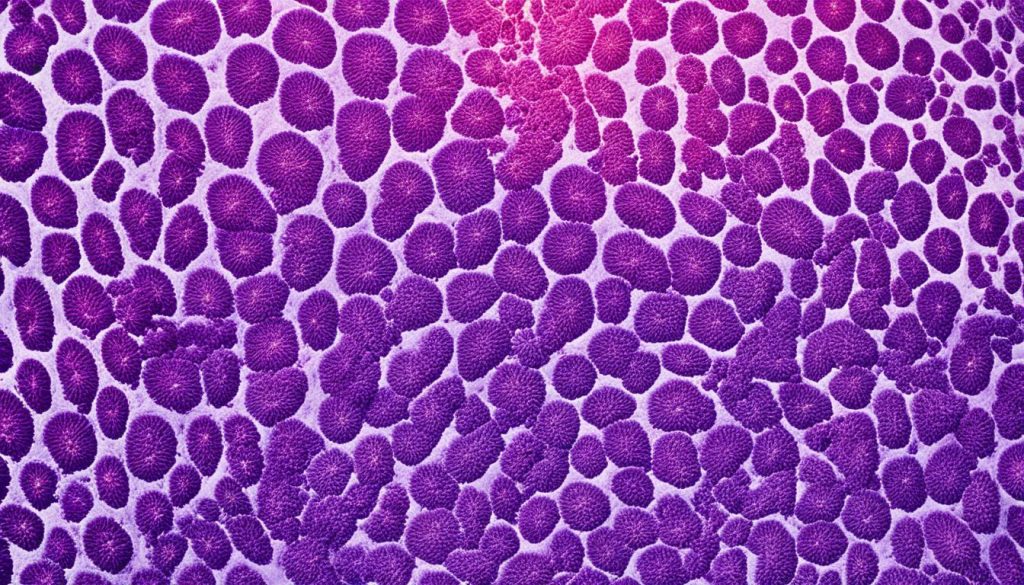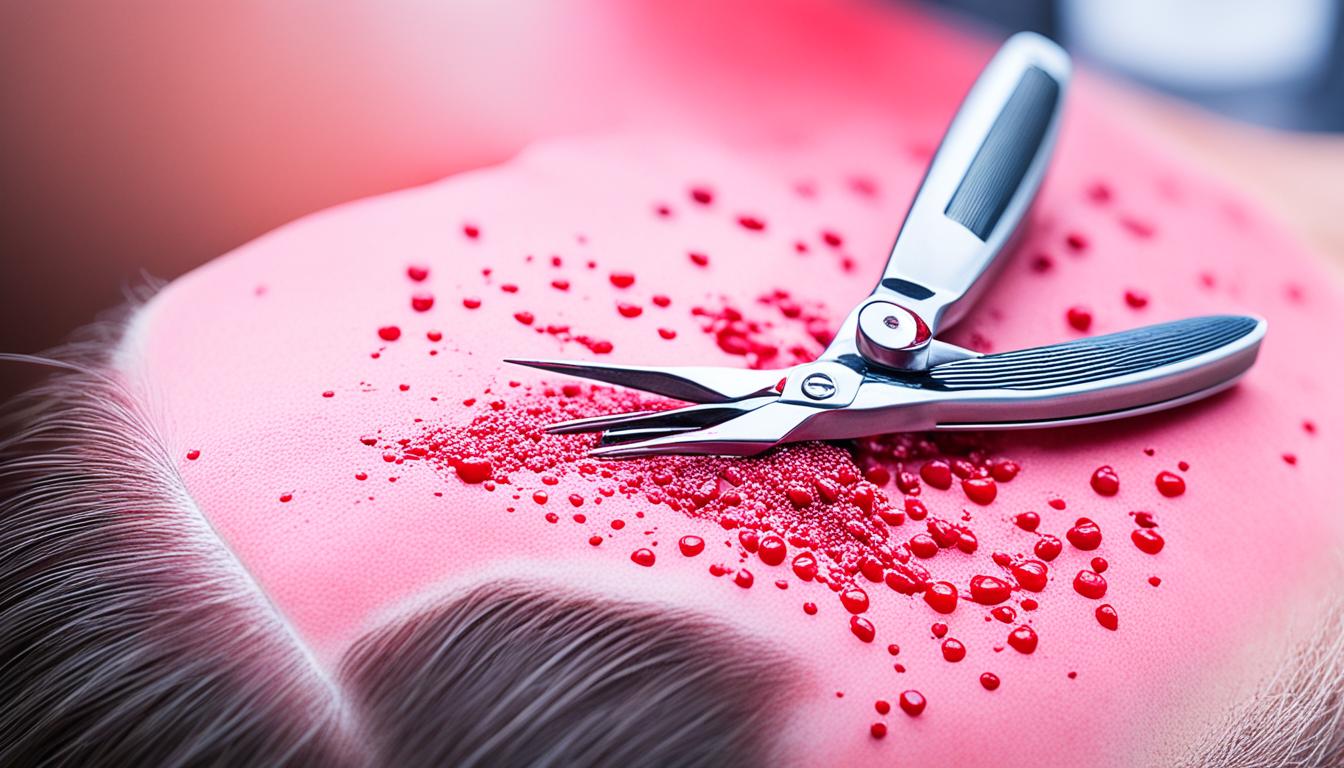Barber’s itch is also known as barber’s rash or folliculitis. It’s a common skin issue, causing discomfort and cosmetic concern. The problem starts when hair follicles get inflamed from bacterial or fungal infections. Symptoms include small, red bumps or whiteheads around hair follicles, leading to itchiness and pain. Depending on how deeply the infection goes, it’s called superficial or deep folliculitis.
The leading cause of barber’s itch is the bacteria Staphylococcus aureus. Yet, viruses, fungi, or ingrown hairs can also provoke it. To diagnose it, doctors usually examine the affected skin. Treatments range from meds and creams to draining pus and laser hair removal. However, stem cell therapy is now emerging as a new, effective treatment for barber’s itch, boosting overall skin health.
Key Takeaways:
- Barber’s itch is a common skin condition characterized by the inflammation of hair follicles.
- Symptoms include small red bumps or whiteheads around the hair follicles, which can be itchy and painful.
- The main cause is a bacterial or fungal infection, but other factors such as viruses, fungi, and ingrown hairs can contribute to the condition.
- Diagnosis is usually based on clinical examination, and treatment options include medication, creams, incision and drainage, and laser hair removal.
- Stem cell therapy is a promising new treatment option for barber’s itch and can help improve overall skin health.
What is Folliculitis?
Folliculitis is when your hair follicles get inflamed. This can be due to bacteria or fungi, causing itchiness and pain. At first, it shows up as small red bumps or whiteheads near the hair. These can turn into hard, painful lumps. If it gets worse, you could lose hair or have scars, making your skin look bad.
There are many kinds of folliculitis, like hot tub rash, razor bumps, and barber’s itch. Hot tub rash is from bacteria in dirty hot tubs. Razor bumps happen when curly hair grows back into the skin, causing irritation. This is common in people who shave close. Barber’s itch is another kind caused by germs in the hair follicles.
How you treat folliculitis depends on how bad it is. For slight issues, just keeping it clean and dry might help. You might need medicines like creams to fight off the infection and lower swelling. Sometimes, doctors have to drain pus from infected spots. Getting rid of hair with laser treatments could also prevent it from coming back. The best treatment depends on what the person needs and wants.
Classification and Causes of Folliculitis
Folliculitis is a common skin problem, divided into two types: superficial and deep folliculitis. Superficial types affect only the top part of the hair follicle. Deep types involve the whole follicle.
Superficial Folliculitis
Superficial folliculitis impacts the surface of the hair follicle. It comes in different forms:
- Infectious folliculitis: Often, bacteria like Staphylococcus aureus get into the hair follicle. This causes swelling.
- Hot tub folliculitis: This kind happens because of Pseudomonas bacteria in unsanitized hot tubs.
- Razor bumps: Known too as pseudofolliculitis barbae, it’s seen when shaved hairs grow back in, irritating the skin. It’s common in men with curly hair who shave close.
- Pityrosporum folliculitis: This type leads to itchy red spots. It’s often on the back and chest, caused by too much yeast named Pityrosporum.
Deep Folliculitis
Deep folliculitis reaches the whole hair follicle. It includes various conditions:
- Chin folliculitis: It mainly shows up in men new to shaving, affecting their chin.
- Gram-negative folliculitis: Sometimes, using antibiotics for acne for too long can lead to this. It happens when certain bacteria grow too much in hair follicles.
- Boils: These are also known as furuncles. They happen when Staphylococcus aureus bacteria go deep into the follicle, causing big, painful, pus-filled bumps.
- Eosinophilic folliculitis: This rare type mainly occurs in people with HIV/AIDS. It leads to itchy, swollen spots on the face and upper body. The exact cause is not known yet.

Risk Factors and Complications of Folliculitis
Folliculitis is a skin issue that anyone can get. Yet, some people have a higher chance of getting it. Those with weaker immune systems, like people with diabetes, leukemia, or HIV/AIDS, are more at risk. Also, having acne or dermatitis increases your chance of getting folliculitis.
Certain medications might also raise your risk. Using steroid creams or antibiotics for a long time can make you more likely to get this skin problem. It’s key to know about these side effects. Talk to your doctor if you’re worried.
Having curly hair or shaving close can also make you more prone to folliculitis. Curly hair often leads to ingrown hairs, causing irritation. Wearing tight clothes can make things worse by trapping sweat and bacteria.
Not using clean hot tubs can also be risky. If hot tubs aren’t clean, bacteria can grow. This bacteria can get into hair follicles and cause infection.
If you don’t treat folliculitis, or don’t manage it well, it can get worse. It might lead to infections that keep coming back. Worse, it can turn into furunculosis, which means really painful boils. Folliculitis can also leave scars or even cause permanent hair loss in severe cases.
Summary of Risk Factors and Complications
The following table summarizes the risk factors and complications associated with folliculitis:
| Risk Factors | Complications |
|---|---|
| Medical conditions affecting the immune system (diabetes, leukemia, HIV/AIDS) | Widespread or recurrent infections |
| Acne or dermatitis | Furunculosis (boils) |
| Use of medications (steroid creams, long-term antibiotic therapy) | Permanent skin damage (scars, bruises) |
| Curly hair and tight clothing | Permanent hair loss |
| Poorly sanitized hot tubs |
Diagnosis and Treatment of Folliculitis
Diagnosing folliculitis involves looking at the skin closely and may include tests. Diagnosis is when a healthcare professional checks the skin for signs of folliculitis. They might swab the skin to find out what’s causing the infection.
The treatment one gets for folliculitis depends on how bad it is. For less severe cases, keeping the skin clean and not wearing tight clothes helps. Good hygiene is also very important.
For serious or ongoing infections, medicines might be needed. Depending on what’s causing it, one might use antibiotics, antifungal, or antiviral meds. These can be creams or pills.
If there’s pus, a doctor may need to drain it. This helps with healing. But only a healthcare professional should do this to avoid any risks.
Laser hair removal can help stop folliculitis, especially for those who get it a lot. It works by targeting the hair roots to reduce infection chances. This method can keep folliculitis away for a long time.
To prevent folliculitis, it’s key to stay clean and be careful when shaving or waxing. Don’t share personal items and use clean hot tubs and pools. Wearing clothes that aren’t too tight can also help avoid skin problems.
Conclusion
Barber’s itch, also known as folliculitis, is a skin problem where hair follicles get inflamed. It’s often caused by germs or fungus, leading to itching, pain, and worries about looks.
There are many ways to treat folliculitis. Keeping clean and wearing loose clothes can help stop and ease symptoms. Doctors may also suggest medicines and creams to fight the infection and lessen swelling. In more serious cases, they might need to remove pus. For a lasting fix, laser hair removal works well against repeated folliculitis.
Stem cell therapy is a new hope for fighting barber’s itch and making the skin better. This therapy uses the power of stem cells to fix damaged hair follicles and improve skin’s health. Knowing what causes folliculitis, its symptoms, and how to treat it allows people to deal with this skin issue effectively.

